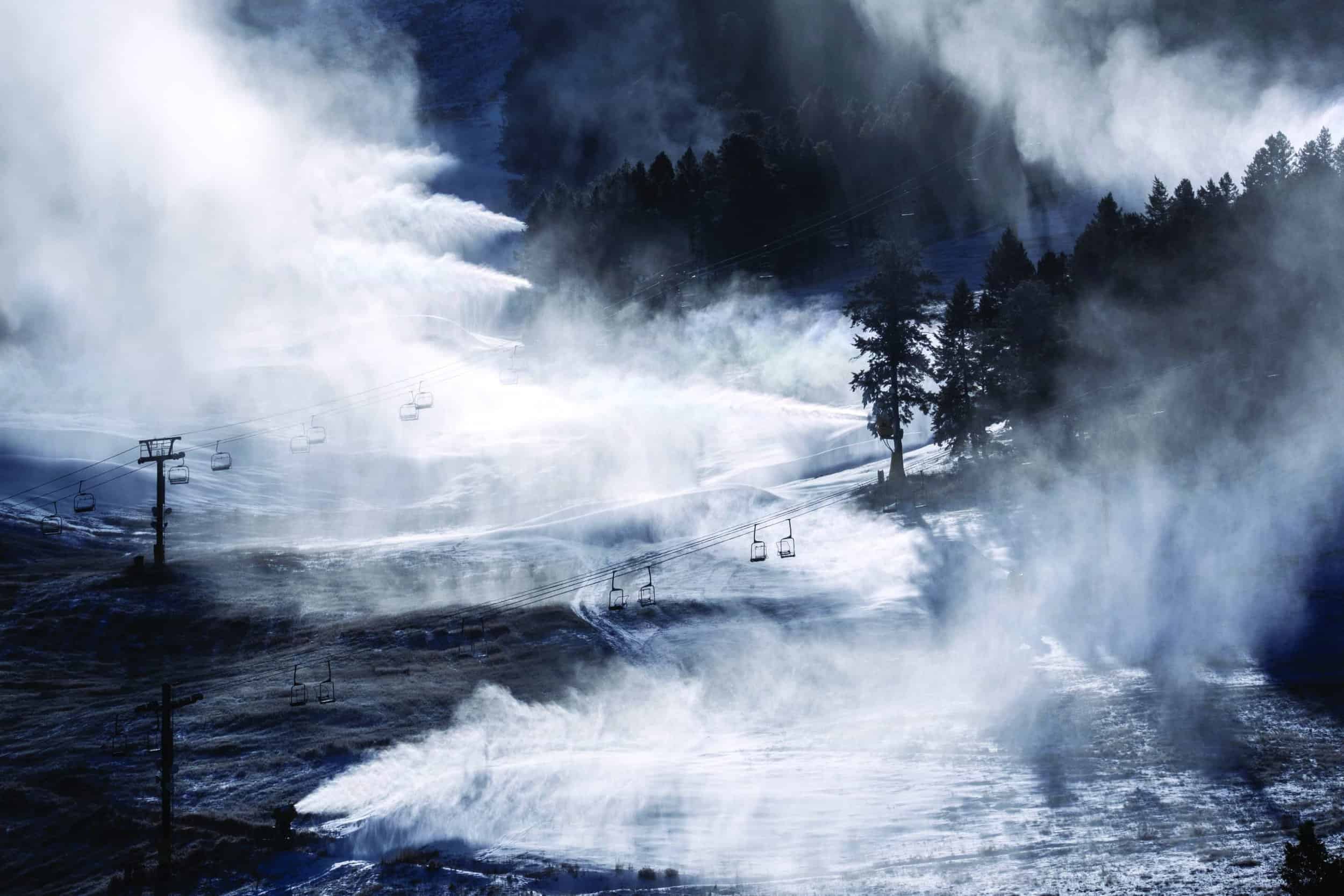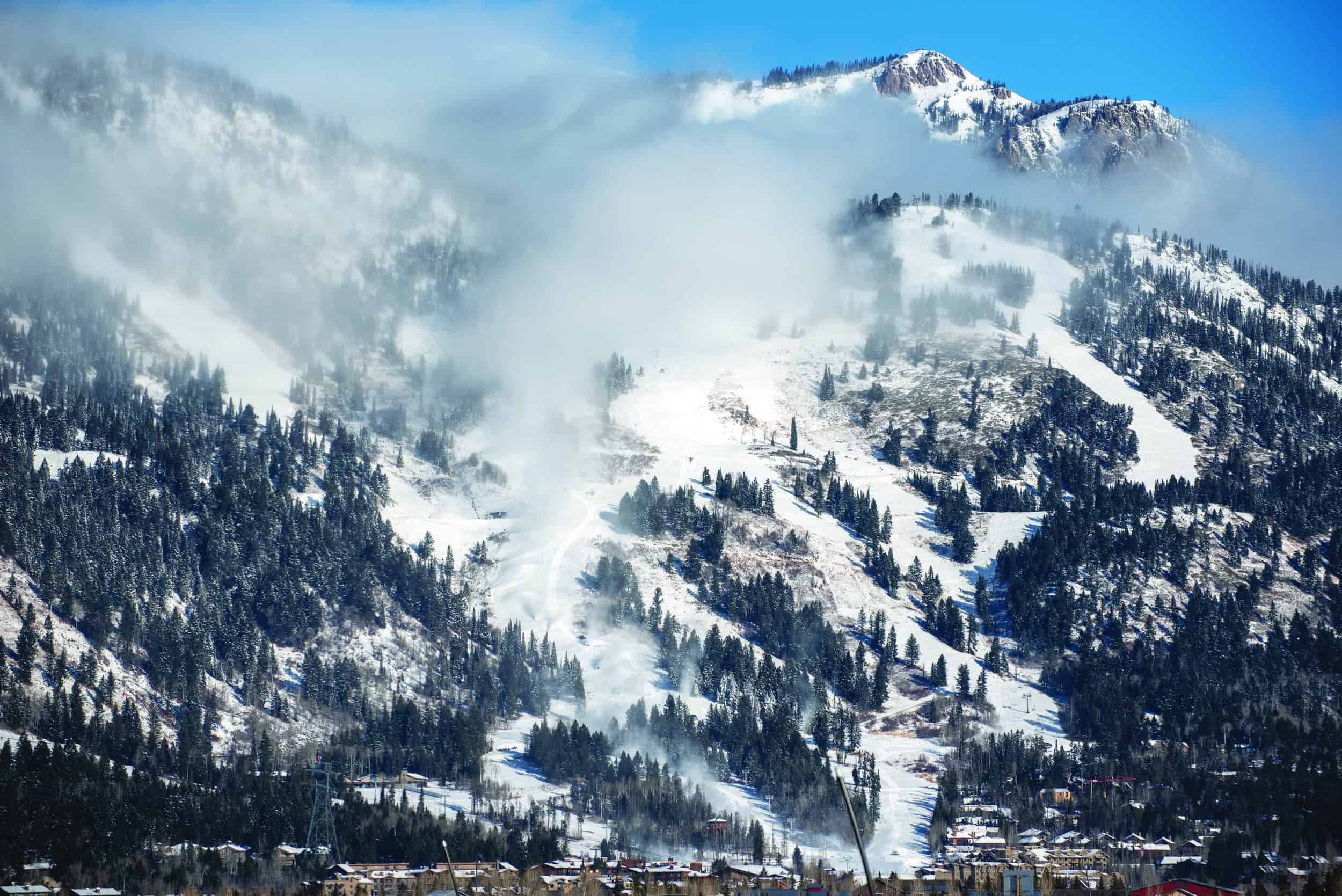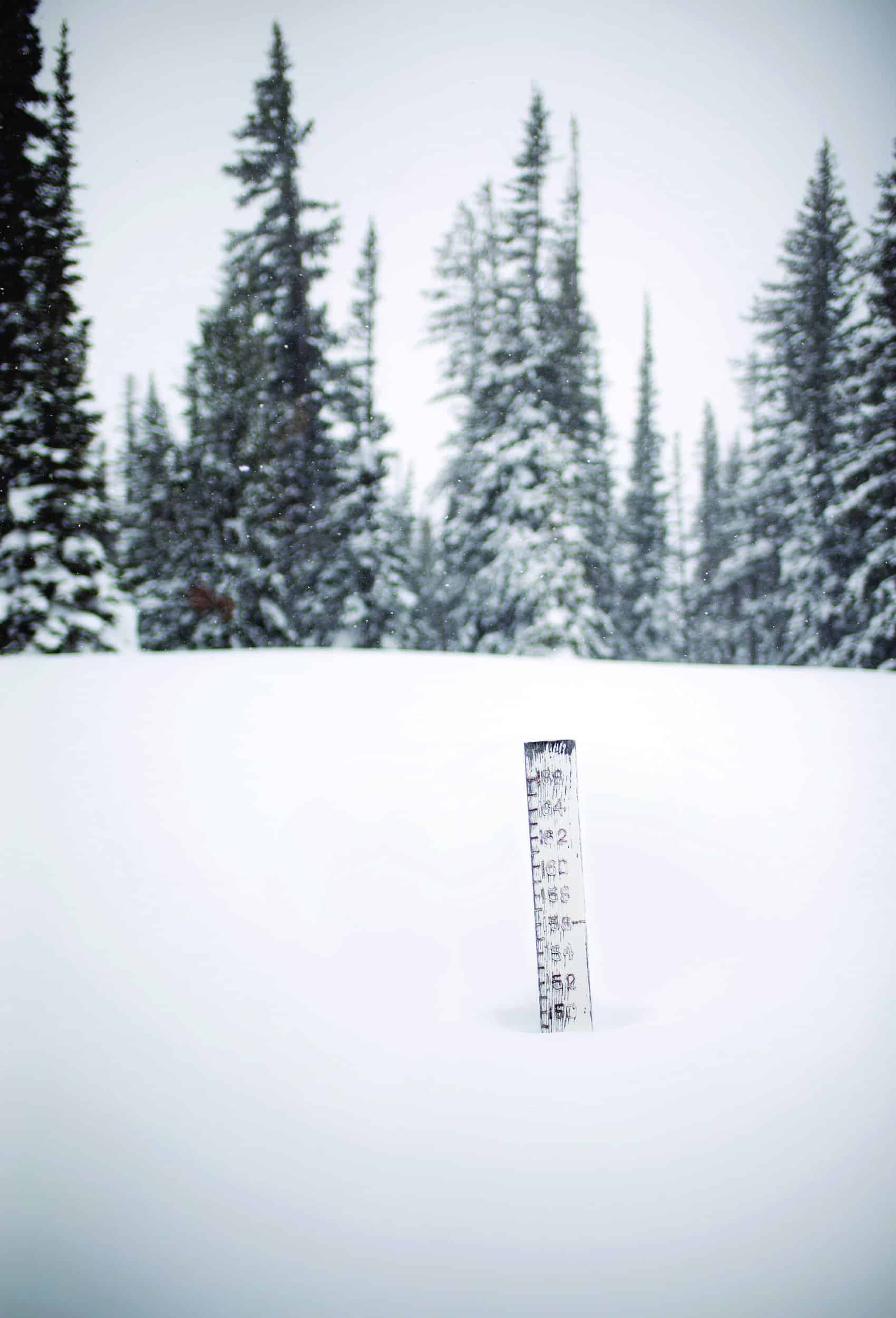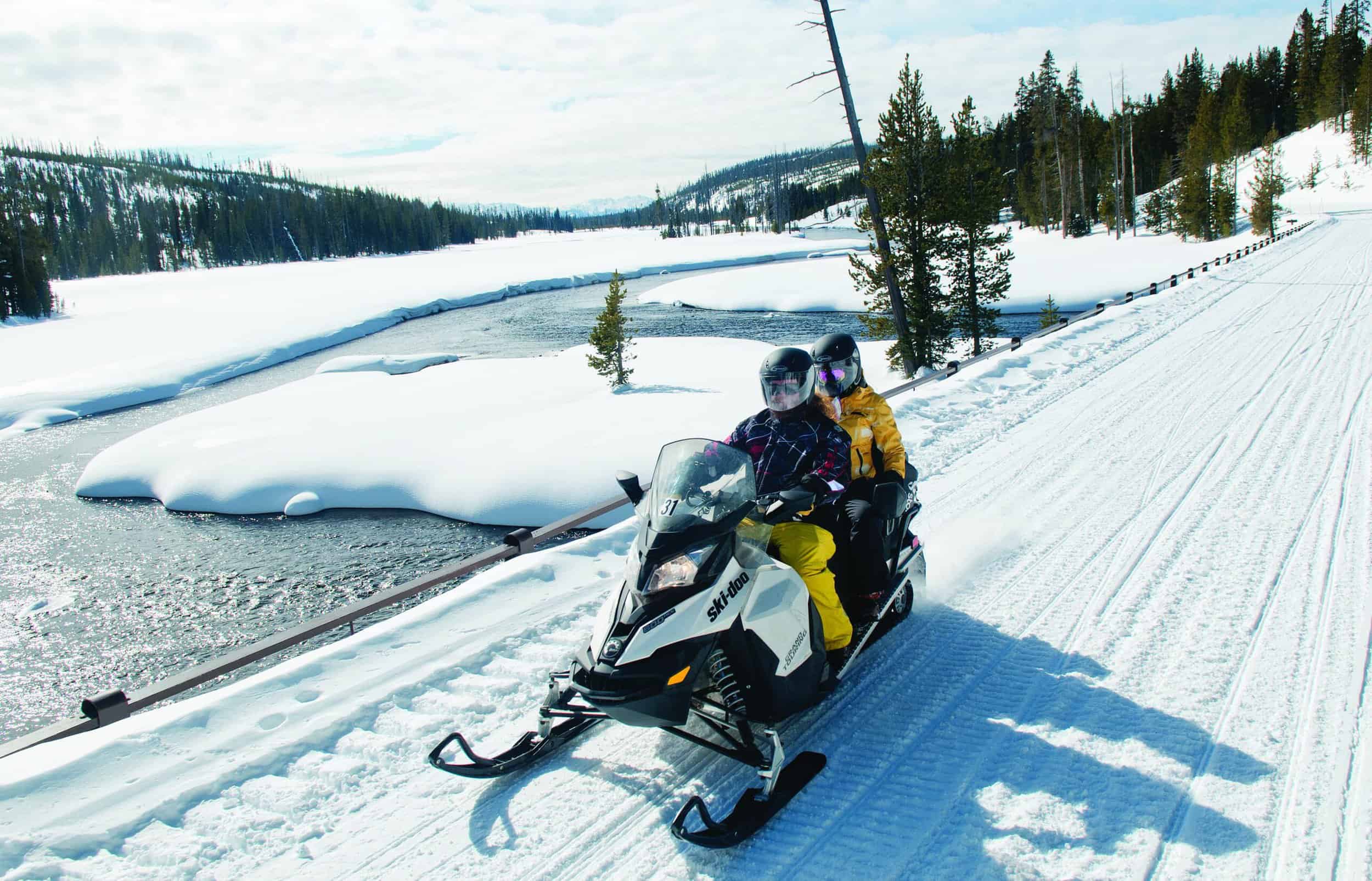Read The
Current Issue
Winters Future: What’s the Forecast?
Climate change won’t do away with skiing in the Greater Yellowstone Ecosystem anytime soon, but it’s assured to transform our winters—and change how and where we recreate.
// By Mike Koshmrl

Picture yourself as a tourist heading to Jackson Hole for a weeklong ski getaway in the heart of winter 2072.
Your electric airliner breezes quietly down over the flats of Grand Teton National Park. The snowcapped Teton Range towers over off to the west, brilliant as ever even though these iconic mountains look different in winter now than they did during the winters of your youth. Across the Tetons’ lowest elevations, there’s a horizontal band of brown, exposed vegetation interrupted only by some white ribbons left behind by snowmaking operations at Jackson Hole Mountain Resort and the deepest, snow-filled canyons. Adjacent to Jackson Hole Airport, waist-high sagebrush bushes are wholly exposed with only a skiff of snow that’s clung to the north side of each plant. As you deplane, the stoke of the trip is dampened, literally. It’s raining in February. Again. You hear a baggage handler grumble that it’s been coming down for three days straight in the valley and leaving only heavy snow up on Teton Pass.
Headed down the highway toward Jackson, nostalgia racks your brain when you see the old ski runs cut into the face of Snow King Mountain. When you skidded by as a ski bum a half century ago, you skinned up those slopes every morning with your first dog. But the historic resort recently phased out its ski season, focusing instead on its more profitable summer ventures. Times have sure changed, though your love of skiing, even into your seventies, persists. And judging by Jackson’s crazy-crowded Town Square, it’s a passion still shared by many.
Now transition out of crystal ball mode.
Sure, that whole hypothetical yarn might come off as a skier’s dystopian nightmare. And yes, there’s plenty of imprecision and supposition involved in predicting anything 50 years out. But review the scientific literature modeling what climate change is likely to do to Jackson Hole’s winters by late in the 21st century, and, unfortunately, it’s not that farfetched of a scenario.
University of Wyoming geophysics professor Bryan Shuman has completed that exercise with vigor while assisting in authoring the 260-page Greater Yellowstone Climate Assessment. That 2021 study amassed past climate projects analyzing the 22-million-acre tri-state (Wyoming, Montana, and Idaho) ecosystem and averaged the results to come up with past and projected changes to temperature, rain and snowfall, and water.
“I think we are going to be one of the few places that have good skiing into the future, especially places like Togwotee Pass and Teton Pass. When I think about book sales, I’m encouraged.But when I think about crowds and the degradation of the skiing, then I feel that it’s really a shame.”
—Tom Turiano, Backcountry adventurer and ski-guide author
And for Shuman, who’s a skier, it was “scary” to see some of the statistics portending the future. Total annual precipitation actually figures to increase the remainder of this century in Jackson Hole and the broader Snake River watershed, but there’s a very notable caveat: warmer temperatures. “And that is, you lose the snow,” Shuman says. “You get more precipitation, but it comes down as rain.” That’s especially going to be true in the fall and spring. And, come winters, in the valleys, it means a strong likelihood of rain in places where today virtually all precipitation is frozen. “The projection is that, even by 2050, you move the snow line up to 8,000 feet,” Shuman says. “You move that snow line even up over the top of Snow King on a regular basis. Those changes over the next couple decades are ones that we probably can’t really turn around at this point, so we’ve got to prepare to adapt to those.”
Representatives for Teton County’s ski areas say they’re doing just that. Jackson Hole Mountain Resort communications director Eric Seymour says his business is taking a three-pronged approach to preparing for climate change. The resort has invested big time in snowmaking, doubling its capacity, and has also diversified its operations by building out summer attractions, from via ferrata to hiking and downhill mountain biking trails. The third part of that strategy is doing its part to offset the resort’s carbon footprint. “Effective September of 2019, the resort shifted to 100 percent wind power,” Seymour says. “And that transition to all wind has produced a 67 percent reduction in CO2 emissions per year.”

From a business perspective in thenearer term, humankind’s influence on the climate could actually be a boon to local ski commerce. Scratching your head? It’s all about geography. Jackson Hole is high, ranging between 6,300 and 13,775 feet in elevation, and it is relatively far north, halfway between the 43rd and 44th parallels. It’s also historically been super snowy; the Snake headwaters are the wettest watershed in the Greater Yellowstone region. The two Teton Range ski areas—Grand Targhee and Jackson Hole—average upward of 450 inches of snow a year.
Simply put, many ski areas that have sparser or heavier snow where the climate is closer to the melting point figure to fare far worse. McKenzie Skiles is a snow hydrology professor at the University of Utah who specializes in near-term winter projections across the Rocky Mountains. “If you’re at high elevations, you’re not going to lose snow anytime soon,” she says. “If someone is concerned about whether there’s going to be skiing at Alta in 50 years, that’s not really a concern. But we might not get quite as much, and we’ll get more frequent rain-on-snow events, because that snow line is just going to keep rising in elevation.”
More dramatic signals of warming and snow loss are in store for ski areas where the snow line can’t climb uphill, because they’re too low to begin with. Think East Coast resorts, Skiles says. The southern Rockies (Colorado, Utah, Arizona, and New Mexico mountains) are also likely to be more affected sooner than northern Rocky Mountain states like Wyoming, Montana, and Idaho. Degrees north in latitude, like elevation, buy time. “But we do see declines in snow-covered areas broadly across the whole Rockies,” she says.
“The projection is that, even by 2050, you move the snow line up to 8,000 feet. You move that snow line even up over the top of Snow King on a regular basis. Those changes over the next couple decades are ones that we probably can’t really turn around at this point, so we’ve got to prepare to adapt to those.”
—Bryan Shuman, University of Wyoming geophysics professor and co-author of the Greater Yellowstone Climate Assessment
The blow that the future is poised to deliver to Jackson Hole’s winters can be hard to fathom. Historic snowfall and cold temperatures are still possible, and it’s winters like that of 2018–2019 that make longtime valley meteorologist Jim Woodmencey wonder if the world-changing force of climate change is somehow sparing Jackson Hole. Spoiler: It’s not. But that February three years ago was epic and reminiscent of the old times, with massive avalanches all around the valley and an extraordinary record of 16 feet of snow that fell at Jackson Hole Mountain Resort’s 9,580-foot Rendezvous Bowl weather station. Snowfall at the Jackson Climate Station in town was likewise off the charts: 55 inches came down, burying the old monthly record of 33 inches. Temperatures were 4 degrees colder than average in February ’19 too, making for a memorable beginning to a calendar year that would go on to become the coldest ever recorded in the town of Jackson. “Weather fluctuates, climate fluctuates,” Woodmencey says. “That’s been my observation in the 40-plus years that I’ve been looking at the weather. It goes up and down, and it always will, instead of going in one direction and keeping in that direction.” He cites some of the long-term data that’s amassed at the National Weather Service’s monitoring station on North Cache Street. Eight of the 10 snowiest winters at the Rendezvous plot in the southern Tetons have occurred in the last 15 years. And data from that Jackson Climate Station shows that temperatures in town have actually been on a cooling trajectory since the turn of the century, which was the warmest period on record.
There are geographic niches on the landscape where the climate has belied regional and global trends. There are one or two climate stations in the high-elevation parts of the Snake watershed where there’s almost been a doubling in terms of total amount of snow since 1950, University of Wyoming’s Shuman says. Yet the overall trend during the same period averaged across the basin’s monitoring stations in Wyoming has been 1.1 degrees of warming, an 11 percent loss of snowfall, and peak runoff that comes 15 days earlier. “That really gets at the fact that the patterns here can be kind of interesting and complex,” Shuman says. “But the projections overall are that, even if that’s true in the short-term, long-term the warming catches up with that. Almost all the precipitation in the wintertime above 6,000 feet falls as snow. But by the end of the century, even in situations where we’ve aggressively managed carbon emissions, that snow line moves up to about 10,000 feet.”

When backcountry adventurer and ski-guide author Tom Turiano hears dire projections that get tossed around for the future of skiing elsewhere in the West, his mind goes to the crowds. It’s no secret that a highway here crosses over the Tetons at 8,432 feet, that Togwotee Pass breaches the Continental Divide at 9,659 feet, and that the Jackson Hole Aerial Tram spews out skiers a hundred at a time 10,450 feet above sea level. “I think we are going to be one of the few places that have good skiing into the future, especially places like Togwotee Pass and Teton Pass,” Turiano says. “When I think about book sales, I’m encouraged. But when I think about crowds and the degradation of the skiing, then I feel that it’s really a shame. We already have this dramatic increase in ski use, but it’s going to become even worse when the other ski areas decline dramatically because of climate change.” Careful planning, he says, is needed, and the infrastructure will need to match the coming onslaught of skiers. That doesn’t necessarily mean building our way out of the bind. “I remember when the park redesigned Jenny Lake in the mid-1990s,” Turiano says. “They completely missed the projections for increased use. Cars now park on the highway for a long way on both sides. The lesson is, no matter how big we build the lots, they will always be overwhelmed. We are going to need new, creative, nontraditional leadership to deal with what’s coming.”
It’s not like Snow King is the only swath of Jackson Hole where the skiing stands to be affected significantly by mid- to late century. Low-elevation approaches to popular backcountry ski terrain, like the Snake River Range via the Snake River Canyon, is a place for which Turiano worries. “That’s one of the areas that could really not be accessible anymore without some hiking,” he says. Other popular lines fall into the same boat, where the skin tracks start down low: 25 Short and Maverick in Grand Teton National Park and Mosquito Creek in Wilson. “That kind of stuff is going to
suffer,” Turiano says.
While these are backcountry skiing destinations, other around-town outdoor destinations popular for other forms of winter recreation figure to be equally impacted, if not more. Think fat biking and cross-country skiing—pursuits that often take place along or near the valley’s floor. A 2016 peer-reviewed study headed by Gardiner, Montana, ecologist Mike Tercek predicted that drastic changes are in store for winter access into Yellowstone National Park, when the interior roads are converted into oversnow routes used by snowmobiles and snowcoaches. Assuming the most drastic emissions and warming scenario, the entrance road paralleling the Madison River past West Yellowstone, Montana, is forecasted to hold enough snow for winter vehicles only 55 percent of days between December and March by midcentury, and as few as 29 percent of days by late century. But the southern entrance road into Yellowstone—accessed via Jackson Hole—held up much better in the study: driveable oversnow days covered 95 percent of winter by midcentury and 91 percent by late century.
Another implication of rising temperatures is the changes it will bring to the snow that does fall. Warmer air can carry more moisture. The closer it gets to the melting point, the less likely snow falls as the powder the Tetons are known for. “The skiing wouldn’t be as good,” Woodmencey says. “It would be higher-density snow. You might as well live in the Cascades.” Skiles, the University of Utah professor whose home ski turf is the Wasatch Range, says she’s anticipating a general decline in the quality of skiing, even up in the high peaks. “It is going to be impacted by earlier melts, by more frequent rain-on-snow events,” she says. “So there might not be an entire epic season, like I’ve had many of over my lifetime. The number of great days on the mountain might get fewer and fewer.”
Currently in Jackson Hole there are about 250 days where air temperatures dip below freezing each year. That’s projected to decline to about 225 days—so losing a few weeks—by midcentury. By the later part of this century, this number could be as low as 150 days.
At least inbounds on managed terrain, resorts like Jackson Hole and Snow King will have the option of falling back on snowmaking to ensure skiing remains. It’s a viable approach to counteract climactic changes as long as the air temps dip below freezing. “Nighttime temperatures are still likely to be pretty cold,” Shuman says. “The other thing that might help here in Jackson Hole is we could get temperature inversions in the valley. That could help.” Snow King general manager Ryan Stanley says he’s seen firsthand that snowmaking can help. The climate models and desire to ensure the town’s resident ski area (and the first ski area in Wyoming when it opened in 1939) maintains consistent winter seasons are part of the reason why the resort is in the process of adding a larger pumphouse and approximately doubling the acreage of terrain where it blows snow. “Snowmaking is critical,” Stanley says. “We’ve had plenty of rain events at Snow King, and what generally happens is, if we have a good snowmaking base, it really doesn’t impact us that much.” But slopes that don’t have an artificial base get much more affected, he added.
Stanley, like Turiano, is anticipating that the wave of interest in skiing Jackson Hole keeps growing. “I think, frankly,” he says, “Snow King is going to benefit in the next 20 years from some of the impacts of climate change in other parts of the country.” But what might happen late this century, when temperature regimes are so dramatically changed in the Yellowstone region that large swaths of the landscape that hold snow today in the winter no longer do? According to the Greater Yellowstone Climate Assessment, “intermediate” warming likely to occur if humanity eases its climactic impact will shrink the heft of the snowpack 24 to 31 percent by midcentury and by 38 to 44 percent come century’s end. Even though there’s projected to be more annual precipitation, there will simply be fewer days when that moisture could possibly freeze. Right now in Jackson Hole, there are about 250 days where air temperatures dip below freezing each year. That’s projected to decline to about 225 days—so losing a few weeks—by midcentury. “But then in the later part of the century, depending on our policy choices, we end up with about 200 days below freezing, or even down to about 150,” Shuman says.
One takeaway that Shuman offered from having studied climate change in the Greater Yellowstone Ecosystem is that there’s still time to stave off the worst outcomes. And actions that are or aren’t taken are likely to make or break winter’s future for our children’s children. Nearly 60 percent of the region studied in the Greater Yellowstone Climate Assessment was dominated by snowfall in winter during the base time period, from 1986 to 2005, at which researchers looked. With intermediate warming, that zone shrinks to 27 percent by midcentury (2041–2060) and 11 percent by the end of century (2081–2099). But a worst-case scenario that assumes greenhouse gas emissions continue to climb unabated paints a much grimmer picture.
The extent of the landscape that’s snow dominated shrinks to 17 percent and 1 percent by mid- to late century, respectively. “Depending on what kind of scenario we’re dealing with and what kind of collective outcome we end up with, the later-century changes can be pretty starkly different from each other,” Shuman says. Regardless of climate policies, in the shorter term we’re “locked in” and all but guaranteed to experience shorter, less severe winters. Still, a less-wintry Jackson Hole winter can make for a skiers’ dream in the warmer world coming, so buckle up and get ready for the lift lines. JH


Assuming the most drastic emissions and warming scenario, a 2016 study projected that by mid-century the road along the Madison River in Yellowstone National Park would hold enough snow for winter travel for an average of only 55 percent of the days the park was open for winter use. Photo by Ryan Jones




